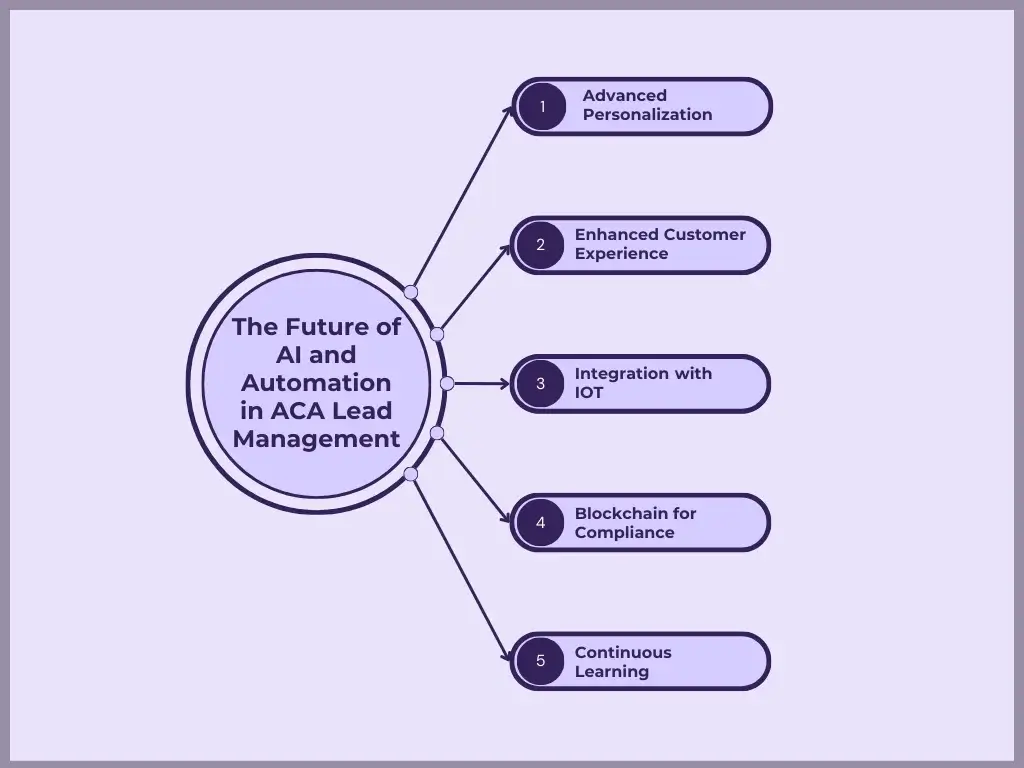
What is the role of AI in ACA lead management?
How do AI and automation help in ACA lead management?
We will tell you everything. Read this blog carefully till the end.
Let’s begin:
In the constantly evolving and intensely competitive healthcare industry, the Affordable Care Act (ACA) has significantly transformed how individuals obtain and administer their health insurance. For enterprises engaged in generating and overseeing ACA leads, it is crucial to remain at the forefront of progress. One highly impactful strategy involves harnessing the capabilities of Artificial Intelligence (AI) and automation.
This blog will explore the transformative role of AI and automation in ACA lead management, detailing their benefits, applications, and future potential.
ACA Lead Management:
ACA lead management is the process of automating sales leads from their generation through their conversion to customers. Lead generation for ACA entails the process of filtering, capturing, and converting prospective customers in health insurance plans as provided by ACA. This process is particularly important to insurance brokers, agents, and companies that are interested in helping individuals and families get an appropriate health insurance plan.
Challenges In Lead Management For ACA:
ACA lead management is fraught with challenges:
- High Volume of Leads: During open enrollment periods, the volume of inquiries and leads can be overwhelming.
- Data Management: Managing and organizing vast amounts of data is complex and time-consuming.
- Compliance: Adhering to strict regulatory requirements while managing leads adds an extra layer of complexity.
- Personalization: Providing personalized and relevant information to each lead is crucial but challenging at scale.
- Conversion: Turning leads into actual customers requires effective follow-up and engagement strategies.
The Promise of AI and Automation:
AI and automation offer solutions to many of these challenges by streamlining processes, enhancing data management, and enabling more effective customer interactions. Let’s delve into how these technologies are reshaping ACA lead management.
Table of Contents
AI In ACA Lead Management:
1. Lead Generation and Scoring:
The utilization of this artificial intelligence can go through the amount of data in a few seconds and find the prospects better. These tools use various machine learning algorithms to identify in which phase of the purchasing cycle each of the potential targets is most likely to take an interest in the ACA plans turning to these services depending on the target’s current behavior, age, and previous actions. This systematic approach has the advantage of improving the efficacy of the efforts being applied in the generation of leads.
Lead Scoring: AI can also rank leads depending on the likelihood of some of them converting. Working on the same records and defining patterns, AI scores the leads and gives more attention to the top potential leads to sell.
2. Personalization and Customer Engagement:
In essence, the concept of personalization is very important when it comes to the management of leads. Businesses can use AI to study different variables to compile customer profiles that enable the business to communicate with the customer according to his or her needs. For instance, it can suggest the particular ACA plans a lead requires his or her health condition, affordability, and his or her requirements.
Chatbots and Virtual Assistants: With the help of AI-integrated chatbots and virtual assistants, leads can be communicated to in real-time with information, answers to questions, and on how to properly enroll. These tools are online all the time, so leads get immediate and correct assistance.
3. Predictive Analytics:
An example of how AI is applied is Predictive analytics where past data is analyzed to make future predictions. Within ACA lead management, for instance, predictive analysis can predict enrollment patterns to assist a business organization in preparing for demand regarding the use of resources. It can also discover possible possible problems and preventative steps can therefore be taken.
4. Fraud Detection and Compliance:
AI can enhance fraud detection by identifying suspicious patterns and behaviors that may indicate fraudulent activity. This is particularly important in ACA lead management, where compliance with regulations is paramount. AI can help ensure that leads and enrollments adhere to legal requirements, reducing the risk of non-compliance and associated penalties.
Automation In ACA Lead Management:
1. Lead Capture and Data Entry:
Introducing manual input of data can be very tiresome and most often causes a lot of mistakes. It is possible to save time and effort associated with the intake of the lead data by automating the input of the lead data into the CRM systems. Leads can be acquired through automated forms and data extractors that would ensure that lead data is well collated and sorted eliminating workload for the staff and the likelihood of errors to occur.
2. Lead Nurturing and Follow-Up:
Lead nurturing entails follow-ups that must be done frequently and on time. Automation tools can provide and deliver timely messages such as emails, short message services, and other forms of communication to the leads depending on their interactional behavior. Leads cannot be missed, and follow-up is timely, which increases the chances of conversion due to well-coordinated automatic processes.
3. CRM Integration:
Closely linked with CRM systems is important to avoid various issues associated with leads. It should be noted that lead data can be passed through various systems in an automated manner for the use of the selling and marketing departments. It improves people’s cooperation and allows them to make appropriate decisions.
4. Reporting and Analytics:
Leads generated from automation can produce a record of analysis of all activities done in managing the leads. These reports give the much-needed information on how well the leads are being generated, nurtured, and converted. Collecting such statistics allows businessmen to discover the ways of their business development and improve the existing strategies.
The Future of Automation And AI in ACA Lead Management:

The role of AI and automation in ACA lead management is poised to expand further in the coming years. Here are some trends and developments to watch for:
1. Advanced Personalization:
For this reason, as AI technology advances, so does the extent of personalization that enters the ACA lead management system. Lead scoring and nurturing: With the help of AI, it will be possible to use a vast number of variables related to leads to design unique recommendations and messages for every lead.
2. Enhanced Customer Experience:
Natural language generation and machine learning techniques are going to be increasingly prevalent while smoothing the interface between customer and brand. These tools will be capable of delivering more elaborate information than simple queries and thus intensify the information support without calling for human involvement.
3. Integration with IOT:
Leading management of ACA will also involve the Internet of Things (IoT). Smartwatches and other health monitoring tools will create important data that insurance and health advice can leverage to recommend insurance products and provide guidance leading to improved health.
4. Blockchain for Compliance:
Blockchain is capable of improving compliance and data security in the lead management of ACA. Blockchain’s ability to provide a clear and unwritable record of transactions makes the technology adaptable for the proper handling of lead data within the law.
5. Continuous Learning:
New features will be developed for AI systems, and these systems will also evolve. ACA lead management will experience continued improvement in performance through the subsequent application of machine learning algorithms in pattern recognition and advanced predictions.
Key Restrictions and Considerations Regarding The Use of AI in ACA Lead Management:

The Affordable Care Act (ACA) has specific regulations and guidelines that healthcare providers and insurers must follow, especially regarding patient data and administrative processes. While AI and automation offer numerous benefits in healthcare, their use is subject to certain restrictions to ensure compliance with the ACA and other related laws.
Here are the key restrictions and considerations of AI in ACA lead management:
1. Data Privacy and Security:
HIPAA Compliance:
- Protected Health Information (PHI): Any application that involves patient data should therefore follow the HIPAA guidelines with specific regard to PHI. This entails some important measures such as data encryption, access controls, and any form of audit trails available.
- Data Breach Notifications: Organizations in the event of a breach of PHI must follow the HIPAA breach notification rule that requires the affected individual to be notified within 60 days and the Secretary of the Department of Health and Human Services (HHS).
2. Informed Consent and Transparency:
Patient Consent:
- Informed Consent for AI Use: It also mentioned that patients ought to be involved provided that the use of AI and automation instruments is involved in their management, including decision-making. It is important to clearly explain how these technologies affect their care, to the individuals they serve.
- Opt-In/Opt-Out Options: The patient should be allowed to either give consent or not to the processing of their data by the AI systems at any given facility.
3. Bias and Fairness:
Avoiding Discrimination:
- Algorithmic Fairness: AI applications should be implemented and trained to avoid bias or discrimination and hence be used in the ACA eligibility assessment and plan choice.
- Regular Audits: Periodical scrutiny and recalibration of the compounds utilized in the AI devices are essential to reduce any unfair prejudice against patients depending on their demographic characteristics.
4. Regulatory Compliance:
Adherence to ACA Provisions:
- Enrollment and Eligibility Verification: ACA rules must be implemented by the tools used in these processes to provide credible and fairest eligibility outcomes.
- Claims Processing: Computerized claim processing systems used in the managers’ offices are required to operate within set ACA regulatory response requirements to process claims without violating the law on the same.
5. Transparency and Accountability:
Explainability of AI Decisions:
- Algorithm Transparency: To sum it up, the aforementioned AI systems should have at least some form of which how the decision-making is arrived at should at least be traced. This means that one has to be prepared to get systematic information on how these decisions are made, particularly the ones with repercussions on patients and coverage.
- Accountability Mechanisms: There should have been checks within the AI systems so that people can, whenever necessary, countermand the decisions taken by the AI system.
6. Data Quality and Integrity:
Ensuring Accurate Data Processing:
- Data Quality Standards: The implementation of AI and automation tools includes an aspect of data preparation as well as data quality and integrity. This entails the right data inputs which are; the quality of data, the extent of data, and time in processing the data towards arriving at the decision.
- Error Handling and Correction: Any system will have checking accounts to assist in the identification of wrong analyses and aid in their correction before the results are produced.
7. Ethical Considerations:
Patient-Centric AI Use:
- Ethical Use of AI: Real AI apps should be applied in the right way and non-violently; nobody requires negative utilization of applications and the patient’s well-being should be the priority; It is also pertinent to note that the harm possible in medical care is not to be underrated by technologies.
- Human Oversight: As the paper demonstrated, the automotive insurance business is built on automation, however, it is mandatory to deal with it and supervise it with the help of people. Last but not least is the interaction in which the intelligent healthcare professionals monitor the AI-driven processes and the integration of the AI processes conducted by the intelligent healthcare professionals.
Conclusion – AI In ACA Lead Management
ACA lead management with assistance from AI and automation in the business is radically changing how prospects are found, contacted, and converted. Thus, the use of these technologies can help the companies address the issue of high lead volume and manage the data flows, compliance requirements, and individual approaches. The benefits of AI and automation are clear: boosting workforce productivity, enhancing customer satisfaction, and increasing the rate of conversion.
Hence, when taking into consideration the dynamics of AI and automation in particular, it is going to play an even more important role of AI in ACA lead Management in the future. Organizations who adopt these technologies will be well placed to adapt to the prevailing health care market competition hence delivering better value to consumers while at the same time meeting companies’ growth goals. The academic calendar is one of the significant areas that have the future agenda towards lead management through ACA AI and automation.
